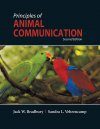About this book
Animal communication continues to be one of the most active and popular topics in behavioral ecology, neurobiology, and evolutionary biology. An enormous amount of relevant new research has been published since the 1st edition, and over 90% of the citations in this new edition were published since the 1st edition appeared.
Although the basic order of topics is similar, this 2nd edition is a completely new book. The topics in the 26 chapters of the 1st edition have been condensed and integrated into 16 chapters in the new version so as to better accommodate upper-division undergraduate courses with 15-week semesters. The text omits boxes and, instead, the relevant mathematics, more advanced considerations, citation bibliographies, and web links for topic enrichment have been assembled into chapter-specific and freely accessible web modules. This was done to improve the flow for undergraduates, while still providing access to more technical details and scholarly sources for graduate courses and professional users. Figures and photos are now full-color and the book has a larger format that makes for easier reading. This edition retains the broad taxonomic and sensory scope of the 1st edition and even adds coverage of several modalities and taxa not discussed in the 1st edition. As with the 1st edition, every chapter concludes with an itemized summary of major points and suggestions for additional reading.
As the title suggests, the emphasis in the text is on identifying general principles that apply broadly across taxa and modalities. At the same time, major effort has been expended to integrate these principles with the accepted principles of economics and other fields of science. Given this integrative nature, animal communication is a topic that can serve both as an appealing entry point to science for younger students and as a coalescing of separate disciplines for more senior ones.
Contents
1. Signals and Communication
2. Sound and Sound Signal Production
3. Sound Signal Propagation and Reception
4. Light and Visual Signal Production
5. Visual Signal Propagation and Reception
6. Chemical Signals
7. Short Range Modalities
8. Signals and Information
9. The Economics of Communication
10. Signal Evolution
11. Conflict Resolution
12. Mate Attraction and Courtship
13. Social Integration
14. Environmental Signals
15. Communication Networks
16. The Broader View
Customer Reviews
Biography
JACK W. BRADBURY is Robert G. Engel Professor of Ornithology, Emeritus at Cornell University, USA. He undertook his undergraduate work at Reed College and received his Ph.D. in Animal Behavior from Rockefeller University, USA. During his career he has served on the faculty of Rockefeller University, the University of California at San Diego (UCSD), and Cornell University, as Associate Dean of Natural Sciences at UCSD, and most recently, as Director of the Macaulay Library at the Cornell Laboratory of Ornithology, USA. His research has included studies on determinants of dispersion, mating systems, and communication in a variety of taxa, ranging from opisthobranch molluscs to various birds and mammals, with most work undertaken in the New World and African tropics. He has been teaching undergraduate courses in animal communication since 1970.
SANDRA L. VEHRENCAMP is a recent Professor Emeritus at Cornell University, USA, at the Laboratory of Ornithology and the Department of Neurobiology and Behavior. She received her B.A. with Honors from the University of California, Berkeley and her Ph.D. in Animal Behavior from Cornell University, USA. Since 1976, she has served on the faculty of the University of California at San Diego and Cornell University. Her research has included field and theoretical studies of cooperative breeding, determinants of skew in reproductive success within social groups, the role of resource dispersion in shaping social structure, the role of energetic limits on display behavior in competitive mate attraction systems, and the evolution of song structure and vocal repertoire size in various songbirds. She, too, has travelled widely in both the Americas and the Old World tropics in pursuit of her studies, and focal taxa have included bats, antelopes, fiddler crabs, waterbugs, cuckoos, jays, grouse, parrots, wrens, and song sparrows. She has been teaching animal communication courses since 1986.



































